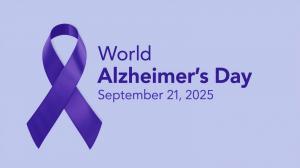World Alzheimer’s Day: Busting the Myths About Alzheimer’s Disease
At Zest, we’re shining a light on the truth by tackling some of the most persistent myths around Alzheimer's Disease”
LONDON, UNITED KINGDOM, September 19, 2025 /EINPresswire.com/ -- Fact: One in three people born today will develop dementia in their lifetime. It’s a staggering reality that highlights the urgency of tackling one of the biggest health crises of our time. This Sunday, September 21, the world marks World Alzheimer’s Day - a moment to confront a condition already affecting more than 55 million people worldwide, with numbers projected to soar to 139 million by 2050. — Dr. Julia Cooney, CEO & founder, Zest
The impact is not only personal but also economic: dementia costs the global economy over USD 1.3 trillion annually, with the UK alone spending around £42 billion each year, a figure expected to more than double by 2040. Yet despite its scale and devastating toll, Alzheimer’s disease remains shrouded in misunderstanding. At Zest, we’re shining a light on the truth by tackling some of the most persistent myths.
Zest, in collaboration with the University of Cambridge Memory Lab, developed PREMAZ, a validated Digital cognitive assessment (DCA), designed to detect early changes with higher sensitivity than the current gold standard tests. By combining objective, repeatable data with ease of use, PREMAZ fits within the wider shift toward proactive, preventative brain health assessment.
Myth 1: Memory loss is just part of getting older.
Fact: Occasional forgetfulness is a normal part of life. However, Alzheimer’s disease is very different. It is a progressive condition that causes permanent damage to brain cells, leading to profound shrinkage of the brain itself. Over time, a brain with Alzheimer’s can lose around one-third of its total volume, leaving large gaps between tissues that are never seen in healthy aging. The hippocampus - the area of the brain responsible for memory - can shrink by as much as 60%, reduced to just a fraction of its original size.
Myth 2: Nothing can be done to lower the risk.
Fact: Dementia is not inevitable. Research published in The Lancet in 2024 found that up to 45% of dementia cases could be prevented or delayed through lifestyle changes alone. The study highlighted 14 interventions - including a Mediterranean diet, regular aerobic exercise, and optimizing hearing and vision - that together could almost halve future cases if adopted early. Crucially, these steps are most effective when started in mid-life; once dementia has developed, their impact is far more limited. This makes early detection and intervention essential in changing the course of the disease.
Myth 3: If it runs in the family, there’s nothing you can do.
Fact: Fewer than 1% of Alzheimer’s cases are caused by rare genetic mutations that guarantee the disease. Far more common are risk genes such as APOE-ε4, which can increase the likelihood of developing Alzheimer’s but do not make it inevitable. Even with a family history, lifestyle choices and early interventions can play a powerful role in reducing risk. Genetics should be viewed as a reason to take proactive steps, not as a life sentence.
Myth 4: There are no effective treatments available.
Fact: For decades, the only treatments for Alzheimer’s disease focused on easing symptoms, without altering the course of the illness. Drugs like donepezil offered limited benefit and often came with side effects. Recently, however, the FDA has approved new therapies - lecanemab and donanemab - that can actually slow disease progression. While not cures - and still controversial due to cost, side effects, and access - they represent a major scientific breakthrough. Crucially, these drugs are only effective in the earliest stages of Alzheimer’s, highlighting the importance of early detection and timely diagnosis.
Myth 5: People don’t want to know if they’re at risk.
Fact: Surveys by Alzheimer’s.org show that 75% of people would be interested in a simple test to detect Alzheimer’s early, and most would prefer to know even before symptoms affect daily life. Awareness gives families control, allows for better planning, and opens access to new treatments and clinical trials. However, many healthcare providers are lagging behind, assuming that patients want to adopt a “head in the sand” approach. Despite the growing range of treatment options available, there remains a reluctance in the clinical space to screen for dementia like we do for other conditions.
Myth 6: Women and men face the same risk.
Fact: Almost two-thirds of people with Alzheimer’s are women. Longer life expectancy plays a role, but scientists are also investigating biological and hormonal differences. This makes proactive brain health strategies particularly important for women.
Myth 7: Traditional testing tools like MoCA and MMSE are sufficient.
Fact: The tests most commonly performed by doctors to assess cognitive health are simple paper-based tests like the MoCA (Montreal Cognitive Assessment) and MMSE (Mini-Mental State Exam), but they are not the best or only tests available. While these tests remain useful, they often miss the earliest and most subtle signs of decline. By the time a patient fails a MoCA or MMSE, brain changes may have been progressing for decades. More sensitive digital assessments and emerging blood biomarker tests are redefining early detection, opening opportunities to intervene sooner and reduce the global impact of the disease.
What Can You Do Today?
If you are interested in early screening, speak with your healthcare provider and ask if they offer PREMAZ, a Cambridge University-validated digital assessment that can detect subtle memory changes long before symptoms appear. For families and individuals, early screening offers reassurance and empowers lifestyle changes that protect long-term brain health.
A Note for Clinicians
World Alzheimer’s Day highlights the growing demand for preventative approaches in cognitive health. Patients are increasingly seeking answers long before symptoms interfere with daily life, creating a need for tools that go beyond traditional pen-and-paper tests.
DCAs are emerging as a scalable first line of detection. By capturing subtle changes across many memory domains, they can help reassure patients, flag early decline, and guide timely referrals. While not a substitute for blood biomarkers or specialist evaluations, they offer clinicians a practical way to integrate prevention and monitoring into routine care.
Contact Zest at support@zest.science to learn how PREMAZ can be integrated into your practice.
Maria Doyle
Doyle Strategic Communications
+1 781-964-3536
email us here
Visit us on social media:
LinkedIn
Instagram
Legal Disclaimer:
EIN Presswire provides this news content "as is" without warranty of any kind. We do not accept any responsibility or liability for the accuracy, content, images, videos, licenses, completeness, legality, or reliability of the information contained in this article. If you have any complaints or copyright issues related to this article, kindly contact the author above.



